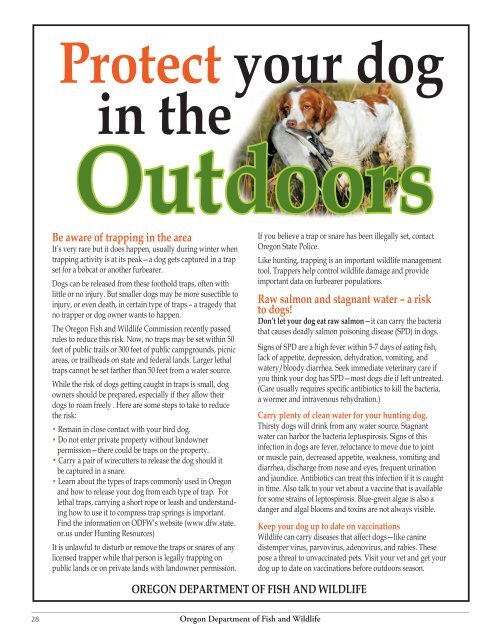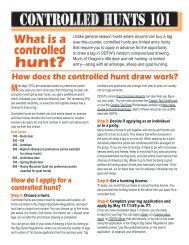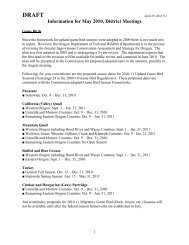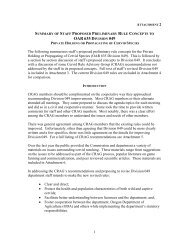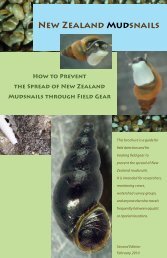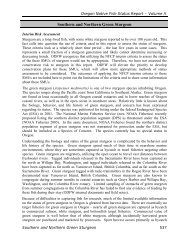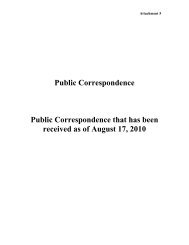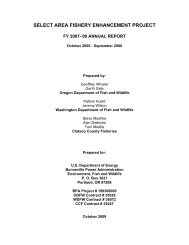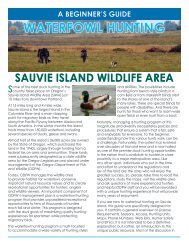Game Bird Regulations - Oregon Department of Fish and Wildlife
Game Bird Regulations - Oregon Department of Fish and Wildlife
Game Bird Regulations - Oregon Department of Fish and Wildlife
You also want an ePaper? Increase the reach of your titles
YUMPU automatically turns print PDFs into web optimized ePapers that Google loves.
28<br />
Protect your dog<br />
in the<br />
Outdoors<br />
Be aware <strong>of</strong> trapping in the area<br />
It’s very rare but it does happen, usually during winter when<br />
trapping activity is at its peak—a dog gets captured in a trap<br />
set for a bobcat or another furbearer.<br />
Dogs can be released from these foothold traps, <strong>of</strong>ten with<br />
little or no injury. But smaller dogs may be more susectible to<br />
injury, or even death, in certain type <strong>of</strong> traps – a tragedy that<br />
no trapper or dog owner wants to happen.<br />
The <strong>Oregon</strong> <strong>Fish</strong> <strong>and</strong> <strong>Wildlife</strong> Commission recently passed<br />
rules to reduce this risk. Now, no traps may be set within 50<br />
feet <strong>of</strong> public trails or 300 feet <strong>of</strong> public campgrounds, picnic<br />
areas, or trailheads on state <strong>and</strong> federal l<strong>and</strong>s. Larger lethal<br />
traps cannot be set farther than 50 feet from a water source.<br />
While the risk <strong>of</strong> dogs getting caught in traps is small, dog<br />
owners should be prepared, especially if they allow their<br />
dogs to roam freely . Here are some steps to take to reduce<br />
the risk:<br />
• Remain in close contact with your bird dog.<br />
• Do not enter private property without l<strong>and</strong>owner<br />
permission—there could be traps on the property.<br />
• Carry a pair <strong>of</strong> wirecutters to release the dog should it<br />
be captured in a snare.<br />
• Learn about the types <strong>of</strong> traps commonly used in <strong>Oregon</strong><br />
<strong>and</strong> how to release your dog from each type <strong>of</strong> trap. For<br />
lethal traps, carrying a short rope or leash <strong>and</strong> underst<strong>and</strong>ing<br />
how to use it to compress trap springs is important.<br />
Find the information on ODFW’s website (www.dfw.state.<br />
or.us under Hunting Resources)<br />
It is unlawful to disturb or remove the traps or snares <strong>of</strong> any<br />
licensed trapper while that person is legally trapping on<br />
public l<strong>and</strong>s or on private l<strong>and</strong>s with l<strong>and</strong>owner permission.<br />
<strong>Oregon</strong> <strong>Department</strong> <strong>of</strong> <strong>Fish</strong> <strong>and</strong> <strong>Wildlife</strong><br />
If you believe a trap or snare has been illegally set, contact<br />
<strong>Oregon</strong> State Police.<br />
Like hunting, trapping is an important wildlife management<br />
tool. Trappers help control wildlife damage <strong>and</strong> provide<br />
important data on furbearer populations.<br />
Raw salmon <strong>and</strong> stagnant water – a risk<br />
to dogs!<br />
Don’t let your dog eat raw salmon—it can carry the bacteria<br />
that causes deadly salmon poisoning disease (SPD) in dogs.<br />
Signs <strong>of</strong> SPD are a high fever within 5-7 days <strong>of</strong> eating fish,<br />
lack <strong>of</strong> appetite, depression, dehydration, vomiting, <strong>and</strong><br />
watery/bloody diarrhea. Seek immediate veterinary care if<br />
you think your dog has SPD—most dogs die if left untreated.<br />
(Care usually requires specific antibiotics to kill the bacteria,<br />
a wormer <strong>and</strong> intravenous rehydration.)<br />
Carry plenty <strong>of</strong> clean water for your hunting dog.<br />
Thirsty dogs will drink from any water source. Stagnant<br />
water can harbor the bacteria leptospirosis. Signs <strong>of</strong> this<br />
infection in dogs are fever, reluctance to move due to joint<br />
or muscle pain, decreased appetite, weakness, vomiting <strong>and</strong><br />
diarrhea, discharge from nose <strong>and</strong> eyes, frequent urination<br />
<strong>and</strong> jaundice. Antibiotics can treat this infection if it is caught<br />
in time. Also talk to your vet about a vaccine that is available<br />
for some strains <strong>of</strong> leptospirosis. Blue-green algae is also a<br />
danger <strong>and</strong> algal blooms <strong>and</strong> toxins are not always visible.<br />
Keep your dog up to date on vaccinations<br />
<strong>Wildlife</strong> can carry diseases that affect dogs—like canine<br />
distemper virus, parvovirus, adenovirus, <strong>and</strong> rabies. These<br />
pose a threat to unvaccinated pets. Visit your vet <strong>and</strong> get your<br />
dog up to date on vaccinations before outdoors season.<br />
OREGON DEPARTMENT OF FISH AND WILDLIFE


